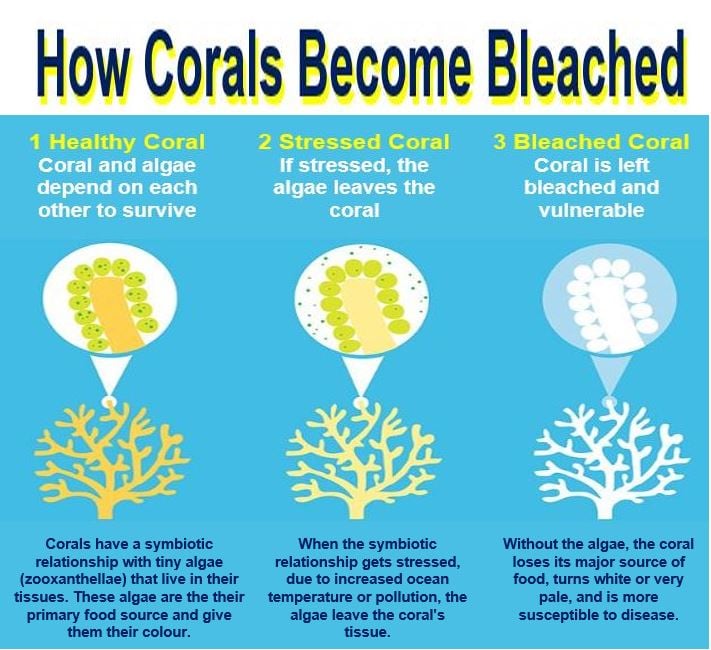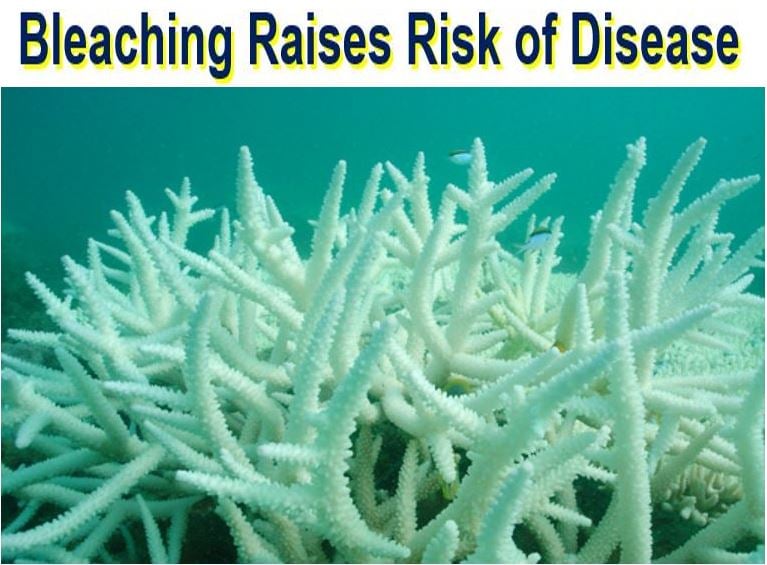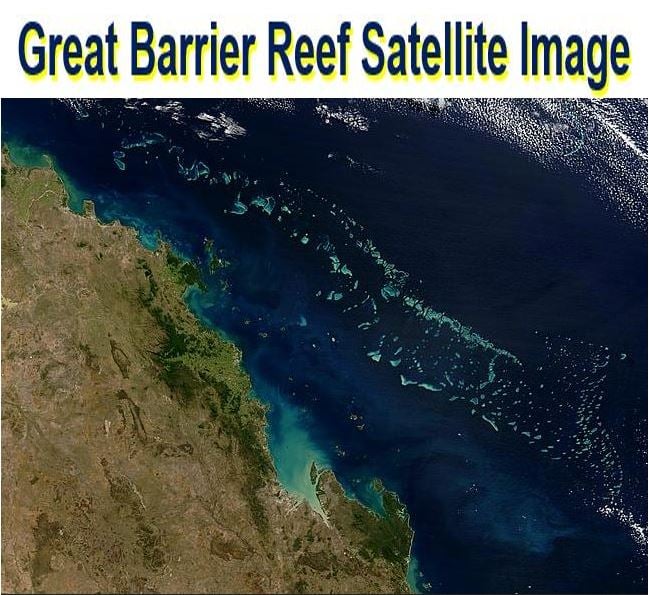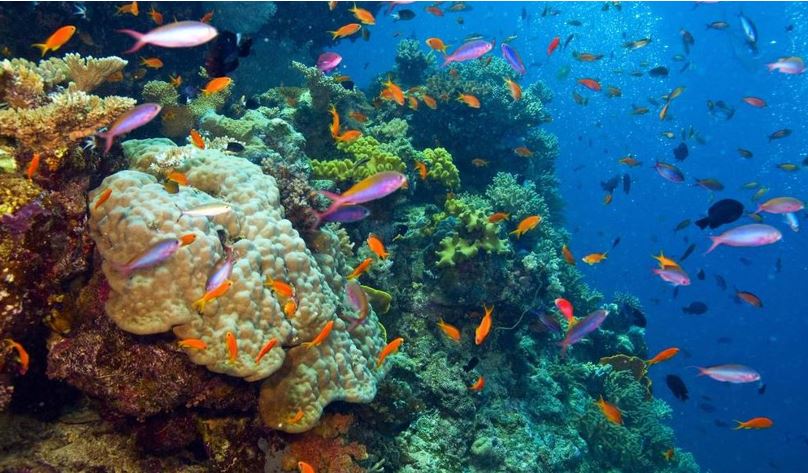The northern part of the Great Barrier Reef, the largest living thing on Earth, has literally been ‘fried’ in the worst coral bleaching event ever recorded, says reef expert Professor Terry Hughes. The Australian Federal Government has failed to protect the reef, which is so large it can be seen from outer space, he added.
The Great Barrier Reef, off the coast of Queensland in northeastern Australia, is a 2,300 kilometre-long (1,429 miles) ecosystem consisting of thousands of reefs and hundreds of islands comprising more than six-hundred different types of hard and soft coral.
 According to the National Oceanic & Atmospheric Administration: “Warmer water temperatures can result in coral bleaching. When water is too warm, corals will expel the algae (zooxanthellae) living in their tissues causing the coral to turn completely white. When a coral bleaches, it is not dead. Corals can survive a bleaching event, but they are under more stress and are subject to mortality.” (Image: uq.edu.au)
According to the National Oceanic & Atmospheric Administration: “Warmer water temperatures can result in coral bleaching. When water is too warm, corals will expel the algae (zooxanthellae) living in their tissues causing the coral to turn completely white. When a coral bleaches, it is not dead. Corals can survive a bleaching event, but they are under more stress and are subject to mortality.” (Image: uq.edu.au)
The reef is home to countless species of molluscs, starfish, sharks, dolphins, turtles and a huge variety of colourful fish.
Corals now don’t have time to recover
Prof. Hughes, convenor of the National Coral Bleaching Taskforce, warns that major and potentially disastrous bleaching events, driven by global warming, are beginning to occur too frequently – so frequently that the reef, which needs ten years to recover, does not have enough time.
According to the Australian Institute of Marine Science, coral bleaching in the northern Great Barrier Reef (GBR) continued to worsen over the past two weeks, even as cooler weather brought much-needed reprieve to southern and central areas.
Prof. Hughes said:
“After months of El Nino conditions, we had hoped that cloudy weather in the past few weeks would quench the overheating of the Great Barrier Reef along its entire length. Unfortunately, the northern sectors have not cooled down enough, and we’re now recording quite extensive levels of coral bleaching.”
 Coral bleaching can be triggered by a rise in ocean temperatures, runoff and pollution, overexposure to sunlight, and extremely low tides. (Image: adapted from oceanservice.noaa.gov)
Coral bleaching can be triggered by a rise in ocean temperatures, runoff and pollution, overexposure to sunlight, and extremely low tides. (Image: adapted from oceanservice.noaa.gov)
“These northern reefs are in the most remote, pristine area of the Great Barrier Reef and it’s a real tragedy to see them being affected like this. Thankfully the rest of the reef is now safe as the summer heat dissipates.”
The northern Great Barrier Reef, which is 1,000 kilometres (621 miles) long, stretches from Cairns to Cape York.
Seas forecast to remain warm
Dr. Neal Cantin, a research scientist at the Australian Institute of Marine Science, who has been closely monitoring weather and climate patterns over the GBR, said:
“Water temperatures on the Northern Great Barrier Reef for the next few weeks are likely to remain far above average and the corals continue to face a bleaching risk.”
Prof. Hughes has just completed aerial surveys that sadly show devastating levels of bleaching in the northern part of the Great Barrier Reef.
Out of the 520 reefs surveyed between Papua New Guinea and Cairns, only four appear to be unaffected, experts reported after the latest aerial survey.
 The bleaching itself does not kill the corals. However, when they are bleached they are much more susceptible to diseases which can kill them. (Image: acfonline.org)
The bleaching itself does not kill the corals. However, when they are bleached they are much more susceptible to diseases which can kill them. (Image: acfonline.org)
Ninety-five percent of the 516 reefs have at least 30% of their corals affected – a significant proportion of them have more than 60% affected.
The damage so far recorded is considerably greater than the previous record bleaching in 2002, when 18% of reefs had over 30% of their corals affected.
Prof. Hughes was quoted by Sky News as saying: “The north has fried. This is an ongoing, slow-motion train wreck.”
 NASA Visible Earth says that the Great Barrier Reef is “Teaming with life, the region is home to a wide variety of marine animals including over 1500 species of fish, sea snakes, turtles, birds, mollusks, and dugongs.” (Image: visibleearth.nasa.gov)
NASA Visible Earth says that the Great Barrier Reef is “Teaming with life, the region is home to a wide variety of marine animals including over 1500 species of fish, sea snakes, turtles, birds, mollusks, and dugongs.” (Image: visibleearth.nasa.gov)
Despite concern by marine experts and environmentalists over water quality and mining-related port developments, UNESCO decided in 2015 not to list the Great Barrier Reef – a World Heritage listed reef – as ‘In Danger’.
Regarding the actions (or lack) by the Federal Government, Prof. Hughes said:
“I hope these scientific findings will convince the commonwealth government to link its greenhouse gas policies to the vulnerability of the reef to climate change.”
Greg Hunt, Australia’s Environment Minister, who personally witnessed bleaching in the northern reef earlier this month, says the damage is the most severe on record. He added, however, that bleaching in the rest of the marine park, according to what he saw, has been moderate or minor.
 Marco Lambertini, Director General of the World Wildlife Fund, said: “The Great Barrier Reef is one of the planet’s richest ocean habitats, home to endangered species, a valuable economic asset for Australia, and a natural treasure for the whole world. Turning the reef into a dumping ground is the wrong choice for the environment and makes no business sense, particularly to build ports that are unnecessary.” (Image: WWF)
Marco Lambertini, Director General of the World Wildlife Fund, said: “The Great Barrier Reef is one of the planet’s richest ocean habitats, home to endangered species, a valuable economic asset for Australia, and a natural treasure for the whole world. Turning the reef into a dumping ground is the wrong choice for the environment and makes no business sense, particularly to build ports that are unnecessary.” (Image: WWF)
Regarding the causes of coral bleaching, the Great Barrier Reef Marine Park Authority says:
“The main cause of coral bleaching is heat stress resulting from high sea temperatures.Temperature increases of only one degree celsius for only four weeks can trigger bleaching events.”
“If these temperatures persist for longer periods (eight weeks or more) corals begin to die. High water temperatures can affect reefs at regional and global scale.”
“Other stressors can also cause bleaching, including freshwater inundation (low salinity) and poor water quality from sediment or pollutant run-off.”
Shani Tager, Greenpeace Australia Pacific’s Reef Campaigner, said:
“Last month the Queensland environment minister Steven Miles granted environmental authority for the Carmichael mega coal mine. Today the reef is bleaching. This government cannot continue down the path of approving new coal mines. Scientists are adamant. We can have a coal industry or we can have a healthy reef, we cannot have both.”
“Our reef is on the brink. We know reefs can recover from bleaching but only in the right conditions. Dredging at Abbot Point to expand the coal port, and any industrialisation of the reef coast, must be ruled out to give our reef the best chance of recovery.”
Greenpeace warned that if the Carmichael coal mine ever got into full production, it would put 121 million tonnes of greenhouse gas into the atmosphere annually. It would also ship sixty million tonnes of coal directly through the heart of the Reef.
Video – Great Barrier Reef worst coral bleaching ever
Experts say the northern part of Australia’s Great Barrier Reef is going through the worst coral bleaching on record.
